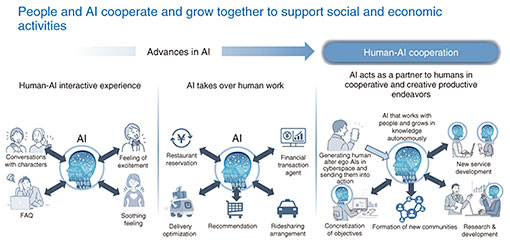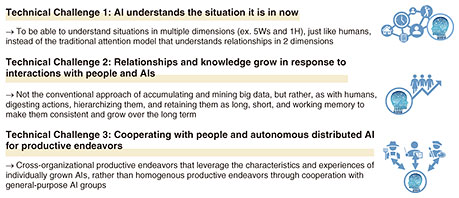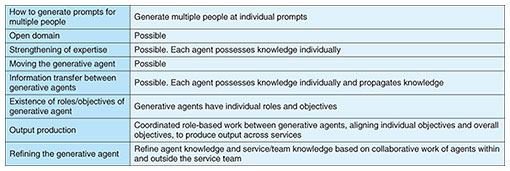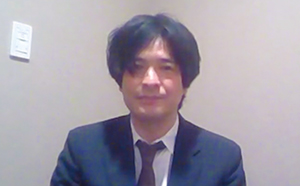 |
|||||||||||||||
|
|
|||||||||||||||
|
Rising Researchers Vol. 22, No. 9, pp. 11–15, Sept. 2024. https://doi.org/10.53829/ntr202409ri1 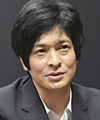 A New World Emerging from Interactions between Humans and AI: Building Human-AI Cooperative InfrastructureAbstractThe artificial intelligence (AI) field offers a variety of services such as chatbots and image generation, including NTT’s proprietary large language model “tsuzumi.” In the midst of the dizzying pace of change, one of NTT’s goals is to create a world in which AI grows autonomously and cooperates with humans. NTT Distinguished Researcher Makoto Nakatsuji believes that building such a world “enables productive endeavors that are more creative,” which are very different from conventional AI-based endeavors. In this interview, we asked him about his current project, “building human-AI cooperative infrastructure with generative AI agents.” Keywords: AI, human-AI cooperation, attention model AI agents that grow together in cooperation with humans enable support for more advanced creative endeavors—First, please tell us about your ongoing research. I am currently working on “building human-artificial intelligence (AI) cooperative infrastructure with generative AI agents.” Simply put, this research aims to build a human-AI cooperative social infrastructure in which AI cooperates with humans in productive endeavors, just like humans. In the past, AI’s main task has been to provide people with an interactive experience and to perform people’s tasks on their behalf. In this research, however, AI provides a very different role from conventional AI, in which AI cooperates as a partner with people (doing things by joining forces) (Fig. 1). As a concrete example, an alter ego AI agent (Another Me [1]) that thinks like you and interacts with people and the environment is generated in cyberspace to grow and cooperate. This will enable productive endeavors that are more creative, such as the development of new services and research and development by or with AI agents in place of or in conjunction with people.
I believe there are three key technical challenges (Fig. 2) that must be addressed in order to achieve such a cooperative relationship. First, Technical Challenge 1 (AI understands the situation it is in now) is to enable AI to understand complex situations in multiple dimensions, e.g., 5Ws and 1H, just like humans. Conventional AI is based on understanding the two-dimensional relationship between “response” and “speech” (two-dimensional attention model [2]), such as learning from a vast history of interactions with humans. In the future, however, I believe that AI can learn the relationship between speech and response in the context of knowledge topics, time, and location, thereby creating a multi-dimensional attention model that better fits human knowledge. In addition, AI’s knowledge distribution can be structured and visualized along a contextual axis, making knowledge sharing with people much easier. Specific results to date include improved precision, with response selection precision on multiple data sets 10 to 30% higher than conventional methods.
Next, Technical Challenge 2 (relationships and knowledge grow in response to interactions with people and AIs) aims for AI agents to acquire and grow relationships and knowledge through autonomous communication using memories and knowledge. The key is to digest and hierarchize actions like a human, rather than using the conventional AI approach of accumulating and mining big data. For example, just like the human brain, memories and knowledge obtained from conversation records, etc., can be organized and managed in order of abstraction. This allows for reusability for future actions, learning and predicting the next action, and dynamically reflecting it in prompts. Technical Challenge 3 (cooperating with people and autonomous distributed AI for productive endeavors) aims to support productive endeavors that are more creative through the autonomous and distributed growth and cooperation of generative AI agents, which are Another Me or a substitute for humans. As an example of my past efforts, I have developed a group chat model for AI characters and am still working on the same type of research. In this model, the AI character learns the user’s habits and preferences, absorbs trends and general knowledge gathered from news and search engines, and attempts to exchange knowledge gathered from other AI characters possessed by other humans. The AI character would then engage with humans and other AI characters to grow autonomously and create cooperative relationships. In other words, the vision of this technology is to leverage the experience and knowledge of individually grown AIs and apply it to current productive endeavors. In doing so, we aim to offer a wide variety of diverse and creative productive endeavors, which are very different from conventional AI-based homogenous productive endeavors. —What services have you been involved with? At the time I started this research, I belonged to NTT Resonant. There, we were developing AI technology and providing services at the same time, so I have a lot of experience in creating systems to achieve a business plan. Specific services include “Love consultation AI Oshieru” [3] on “Teach! goo” and TV character AI “AI Nana-chan” [4] and “AI Kahoko” [5] that I helped produce for Nippon Television Network Corporation in one of their projects. These have thankfully been very well received and used by many users, and have been featured in numerous media outlets. In response to this, there is a trend to provide services with interactive AI. The “AI x Design” [6] service was created, and the “AI suite” [7] service was developed from it. This was an attempt to stay ahead of the times and incorporate not only language, but also audio and video, and personalized AI technology to take advantage of business opportunities. About two years after its launch, I was reassigned to NTT laboratories, but AI suite is still provided by NTT DOCOMO. Thus, during my time at NTT Resonant, I was engaged in research and development while providing a variety of services. In this context, I was trying to devise my own way to explore how to capture the market with AI technology. I was also trying to devise a system that would involve an autonomous cycle of quickly incorporating new technologies into our services and generating revenue from them while conducting further research. Consequently, for about seven years, I have been able to do both the AI business and research and development, and several of my services have been used by a very large number of users. Behind the scenes, the algorithm, which was also accepted by top conferences such as International Semantic Web Conference (ISWC), Association for the Advancement of Artificial Intelligence (AAAI), and International Joint Conference on Artificial Intelligence (IJCAI), was in action, achieving a high level of results in terms of both service and technology. In addition, some of the techniques still have the world’s highest response precision for response selection models in evaluations on Chinese data sets. I am currently developing a new model of human-AI cooperation, called the “miniature garden model” (Table 1). This model allows AI agents to deepen their knowledge through team discussions and conversations on behalf of humans, ultimately outputting business proposals and other documents. Each agent that has been generated has individual expertise and propagates knowledge by discussing with each other. In this way, there is a collaborative process that aligns the individual objective of each agent and the overall goal, and ultimately produces output across services.
Leveraging NTT laboratories’ extensive research results in the field of AI, where “speed” is important—What are some of the approaches that you value in your research? In conducting research in the field of AI, I believe it is very important to keep up with the latest trends and seek out the next trend in research. For example, one of the reasons why the ChatGPT service has spread so much is because they were the first to introduce their service to the market. In addition, we are able to find an answer to the question of whether the direction of the research is really correct by introducing a service to the market. If the service is embraced by the world, we can use it as evidence of the value of further research. When I was a member of NTT Resonant, I would immediately launch AI services in line with the trends of the times, receive feedback, and think about the next research topic on a daily basis. In an environment where I could hear directly from the public and customers, I wondered daily what direction I should take my research in. In addition, AI suite was released very smoothly with the help of several supervisors and team members involved. Meanwhile, as a researcher, I was also facing a very difficult time with the emergence of ChatGPT and how to compete with a huge research organization. This situation has made us think again about the importance of creating a mechanism to systematically bring products to market in a seamless and market-oriented manner, utilizing NTT laboratories’ broad range of researchers and diverse research findings. In research where time is limited, new ideas come out one after another, but unless they are built quickly, experimented on, and patented as soon as possible, other competitors will get a head start. Especially in the AI field with its dizzying pace of change, such risks are always at hand, and I believe that there is a common understanding among researchers that they must proceed with their research with speed. In order not to fall behind in these circumstances, I am always mindful of keeping up with trends through papers and discussions with other researchers. —Finally, do you have a message for researchers, students, and business partners? When I joined NTT in 2003, research on AI, search systems, and the Semantic Web was gaining momentum, and I felt that this field would be truly transformative. I was especially interested in NTT, which runs its business with research at the core. NTT laboratories have an extensive pool of researchers in machine learning and AI, and in fact, NTT researchers make many presentations every year at top conferences such as AAAI and IJCAI. AI technology is at the core of future business opportunities, and I feel that we have a great advantage in pioneering the AI business in Japan. NTT also has a wide range of operating companies that can create services that make use of this advantage, and above all, NTT’s network services and its ability to collaborate with end users are major advantages for the company. I believe it has great potential to be the next game changer, depending on how it is done. In addition, by being able to hear directly from the users of the service, I am able to summarize the results of my research in a paper, which motivates me as a researcher, so I feel that I am in a very fortunate environment in this respect. I rejoined NTT laboratories in July 2023 and am currently conducting research through discussions with a diverse group of people. In doing so, I have noticed things from a new perspective and also felt the importance of taking seriously the results of research from the research field’s community. I think it applies to people around my age that if we can keep in mind to find the value of what other parties want to do in the community, I believe that the discussion will be productive and produce positive results. I also believe that it is necessary to take a broad perspective and move forward with research in a direction that produces results as a whole. I intend to do so and approach my research with utmost sincerity. I believe it is important to continue to demonstrate real-world implementation ahead of the times, while also making an impact from the academic side by aligning milestones with top conferences and other events. I also believe that it is important to conduct creative research activities and exciting work that emerge from collaboration among researchers, whether in research or real-world implementation, and to build such relationships. If anyone reading this is interested, I hope we can collaborate at some point on research that will enhance the AI field.
References
■Interviewee profileMakoto Nakatsuji received his B.S. in systems science from the Graduate School of Informatics, Kyoto University in 2003. In the same year, he joined NTT. In 2010, he completed a doctoral program in social informatics at the Graduate School of Informatics, Kyoto University. He was a visiting scholar at Rensselaer Polytechnic Institute in 2013. He joined NTT Resonant in 2015 and has been with NTT Human Informatics Laboratories since 2023. He received the 2015 Annual Paper Award from the Japanese Society for Artificial Intelligence and the Best Paper Award from the Institute of Electronics, Information and Communication Engineers. After advancing research and development of dialogue systems based on deep learning as well as commercialization projects, he is currently engaged in the research and development of autonomous growth of AI and cooperative endeavors between humans and AI. |
|||||||||||||||

